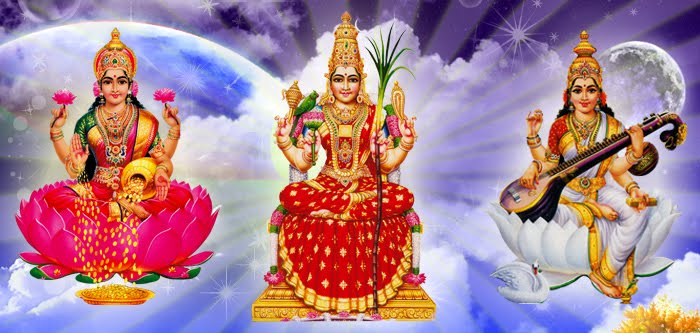Today marks the first night of Navratri 2007 (pronounced Nuh-vuh-rah-trii (as in bee)) in the Indian calendar. Nav = nine and ratri = night. Thus, it is the night nights that are dedicated to the celebration of the goddess.

The first three days/ nights are dedicated to the goddess Durga (pronounced Dour (rhymes with tour) gah (rhymes with hah))
The middle three nights are to honor the goddess Lakshmi (pronounced Luck-shmee not Lock-shmee.)
The final three nights propitiate the goddess Saraswati (pronounced Suh-ruhss-vuh-tea).
The goddess represents the divine feminine power in each of us. In Sanskrit, it is known as the Shakti (pronounced Shuck-tea not Shock-tee).
Durga is the fierce form of the goddess. She is depicted riding on a lion (sometimes a tiger) and has six or eight arms. In them she holds a conch, a discus, a sword, a bow, a trident, a mace and a lotus. One right arm is held out palm face out in abhaya (fearlessness) mudra. Durga means “invincible”. Durga is a protector; she removes suffering, injustice, and cruelty. As the divine mother, she constantly watches over all beings on earth with vigilance. There are 108 names for Durga. Among them are Kali (Kah-lee), the very fierce form of the goddess, and Parvati (Par-vuh-tee), the consort of Lord Shiva, the protector of the universe.
Lakshmi is the goddess of abundance, love, beauty, and good fortune. She sits atop a lotus flower and has four arms. One arm holds a lotus flower, another a conch shell, yet another arm is distributing an endless stream of gold coins, and another is giving blessings to humanity. The word Lakshmi comes from the Sanskrit word “lakshya” which means “aim” or “goal”. She is the goddess of both material and spiritual prosperity. Her four arms represent the four aims of life: dharma (duty), artha (security, which means money), kama (enjoyment) and moksha (liberation). There are elephants depicted on either side of her. Lakshmi is the consort of Lord Vishnu (or Narayan), the operator of the universe.
Saraswati is the goddess of wisdom and the classical arts. Saraswati is traditionally dressed in white and holds a veena (a classical Indian stringed musical instrument, similar to a sitar), a book, and a crystal mala (necklace). Her four arms represent the four Vedas or the four ancient books of Vedic knowledge. She is holding one of the Vedas. The mala represents spirituality; people often use a mala as a focusing tool for repeating a mantra. She is depicted near a flowing river and her vehicle is a swan. The swan is the only creature which can filter out just the milk from a mixture of milk and water. Thus, the swan holds the power of discrimination. This is in line with Saraswati’s connotation with purity. Lord Ganesha is always propitiated before any undertaking to remove any obstacles which may present themselves. In the course of study or any academic endeavors, students are taught at an early age to propitiate Ganesha and then Saraswati. There is also an invocation done for the student/ teacher relationship. Books are considered as sacred knowledge and it is disrespectful to put any book directly on the floor or to touch it with your feet.
Navratri represents a great time of celebration. There are pujas and festivals and dances (called garbas). Abundance, music, and beauty are celebrated. Sweets are baked and shared.
On the inner level, regardless of our race or religion, this is a time to embrace the power of the divine within all of us. Each of us has both a soft, tender side as well as a fierce, protective side. When do we exhibit each of these attributes and to whom? What side do we embrace?
Navratri 2007 follows the time of Pitru Paksha (Pit-true Puck-shuh), the time when we traditionally worship our ancestors. This is a time when we pay homage to those who have come before us; we act with reverence to those who have made it possible for us to exist in this lifetime. We remember from where we have come. Certain rituals are undertaken to pay respect to the departed.
Following this somber time is Navratri. After the nine nights of Navratri is Dassera (Duh-saay-rah), the celebration of good over evil. This holiday is held in honor of Lord Rama and his victory over the demon king Rāvana in the land of Lanka.
In November, we will celebrate Diwali (Dee-vah-lee), the celebration of lights, and then that will culminate in the Indian new year.
Like life, we move from dark to light, from contemplative to celebratory, and from looking back to planning for the future. With this procession of activities, we are able to reflect on the past and then take time to rejuvenate ourselves and rejoice in the new year.